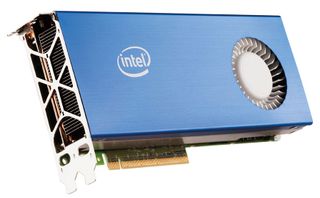Early rumors point to Intel unveiling a discrete graphics card at CES 2019
Let the waiting game begin.

Intel is putting the pieces in place to make a run at the discrete graphics market and looking to compete with the best graphics cards available, scooping up former AMD employees, such as Raja Koduri and Chris Hook. While Intel has not officially announced plans to launch a gaming GPU specifically, it's widely expected the company will, and rumor has it Intel will have something to show off at the Consumer Electronics Show next year.
Anthony Garreffa at TweakTown says he's heard from industry source that Intel has already completed the first phase of its discrete GPU play, and is "now preparing for a launch."
"My sources are telling me to expect late this year with all attention to be placed on Intel at CES 2019 in January, where Intel could unveil its next GPU," Garreffa writes.
When Intel announced that it had brought Koduri on board to lead its newly formed Core and Visual Computing Group (just as he previously led AMD's Radeon Technologies Group), the company indicated it would focus on "high end discrete graphics solutions for a broad range of computing segments." Obviously gaming would fit into the "broad range" category, as would literally everything else related to graphics.
More recently, however, Chris Hook joined Intel to be its "discrete graphics guy" as it pertains to marketing. Before joining Intel, he spent nearly two decades at AMD, dating back to the ATI days. From our vantage point, hiring Chris is a strong indication that Intel will in fact build a gaming GPU, as has been rumored.
Whether it makes a debut at CES 2019 remains to be seen. It wouldn't surprise us either way. If Intel does announce a gaming GPU at CES, we would probably be looking at around April 2019 for actual availability. It's certainly not far fetched, depending on where in the gaming market Intel decides to make a splash—all it really has to do is taking its existing graphics IP, refine it a bit, and slap a bunch of EUs on a chip. That's a gross oversimplification obviously, but the bigger point is, CES 2019 is not unrealistic.
I talked about this with our own Jarred Walton, and here are his thoughts.
The biggest gaming news, reviews and hardware deals
Keep up to date with the most important stories and the best deals, as picked by the PC Gamer team.
"For the record, each EU in Intel's current Gen9 architecture is roughly the equivalent of 8 Nvidia/AMD 'cores' (CUDA cores or Streaming Processors). If Intel optimizes the design and improves performance by 25 percent, and then puts five to ten times as many EUs/cores on a chip, with the requisite increase in memory bandwidth and capacity, it would be relatively competitive. HD Graphics 630 is good for up to 441.6 GFLOPS. So 25 percent + 10X would give 5520 GFLOPS. That's RX 580 levels of performance," Jarred said.
"Even better: a 50 percent increase in per-core performance, with an improved architecture. Then get clockspeeds up to 1.6-2.0GHz (call it 75 percent faster than current Gen9). Now a 10X increase in shader counts would give 11.6TFLOPS, which would be potentially close to 1080 Ti levels of performance. And could easily be scaled down to mid-range parts," Jarred added.
That's just us playing paper chip designers, but with Intel's resources (money, access to chip fabs, and plenty of skilled engineers), just about anything is possible. Intel's graphics drivers have come a long way since the first HD Graphics parts, and currently manage to run (not necessarily well, but at least run) every game we've tried. All it needs now is more potent hardware.
Of course, Nvidia should have something new on tap by CES 2019, and perhaps AMD as well. Whatever happens, it will be interesting to see how Intel approaches the gaming GPU market.
Paul has been playing PC games and raking his knuckles on computer hardware since the Commodore 64. He does not have any tattoos, but thinks it would be cool to get one that reads LOAD"*",8,1. In his off time, he rides motorcycles and wrestles alligators (only one of those is true).
Most Popular






